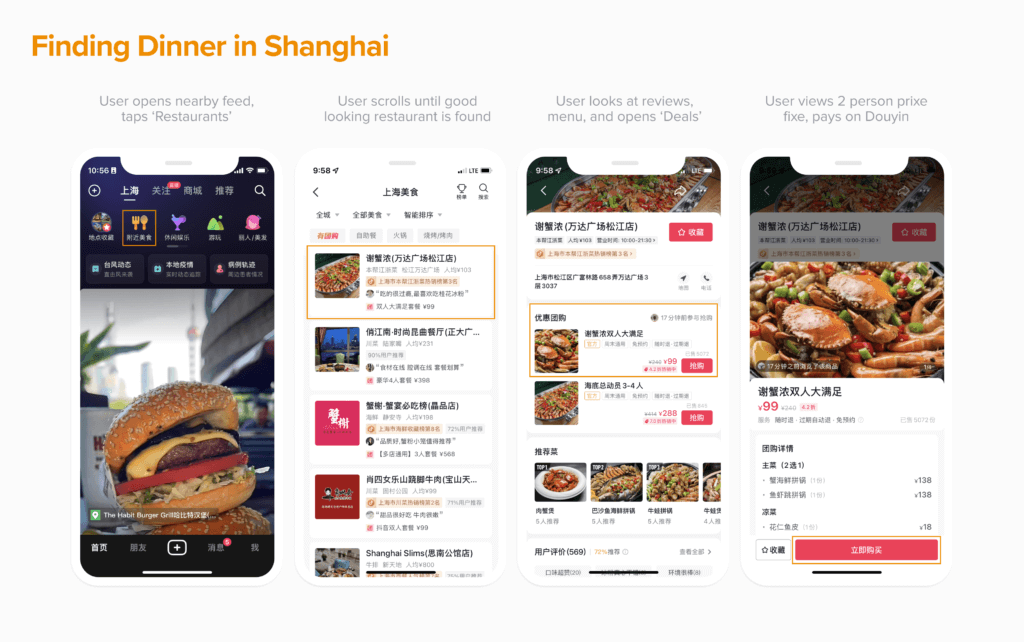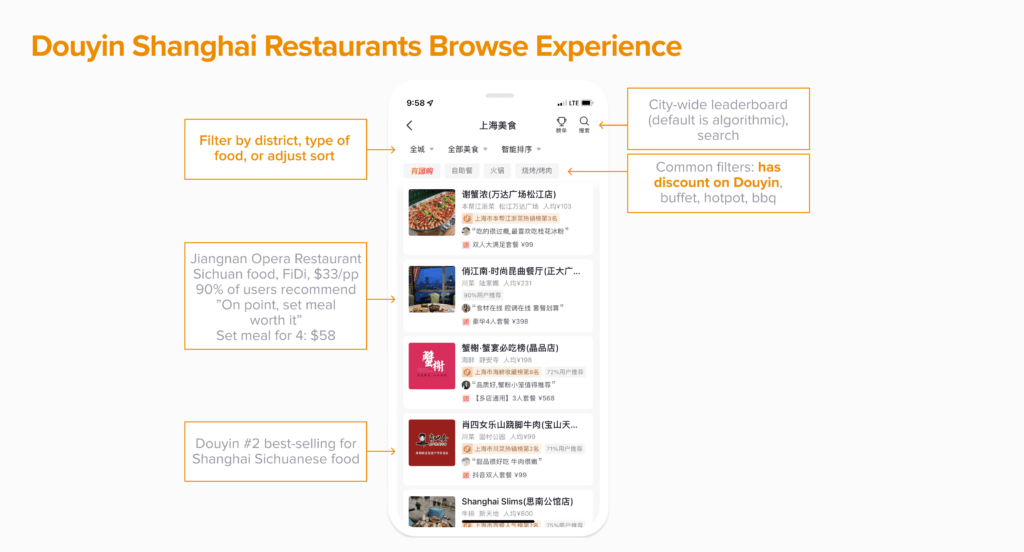It’s no secret today’s young people prefer searching for recommendations on video apps over text-based search engines. Even the executives at Google know this. SVP Prabhakar Raghavan recently said that according to the company’s internal studies, 40% of young people, when looking for a place for lunch, go first to TikTok or Instagram over Google Maps or Search.
The concept of video search is a critical functionality that social media companies are starting to realize they need to figure out… and fast. Why the urgency? The answer is simple: Whoever masters video search will unlock a compelling wedge into in-app commerce and be able to monetize the intent of their users. If a social company were to figure out how to keep their customers’ actions inside of their app, then they could expand their business into commerce and payments, the consumer wallet, and other extremely lucrative features. At the very least, eliminating purchase friction would make the ads on the platform more valuable, because they would expand the capacity for one-click purchases.
Most social media companies are keenly aware of this. Snap, Instagram, and others have been experimenting with video search and trying to build native commerce into their apps for years. Instagram, for one, before it recently announced it was scaling back its shopping features, introduced ideas like location and hashtag Stories, letting users search for Stories based on location and interest tags. But none of these companies have a proven, internal roadmap for expansion quite like TikTok.
What Pinterest was to images, TikTok is becoming for short-form video. Thanks to its infamous algorithm, the Bytedance-owned video platform now has over a billion global monthly active users, and kids and teens reportedly spend an average of 91 minutes watching TikTok per day (versus an average of 56 minutes per day on YouTube). TikTok creators are also posting a seemingly endless amount of content every day—so when it starts to become a search destination, the potential is enormous. Imagine if every piece of video user-generated content (UGC) had a location tag that could redirect to a voucher or other deal. Merchants would benefit, because they would suddenly have a vast number of new, free, and seemingly less-biased UGC “ads” every day for their products/offerings, courtesy of their own customers. This in turn would incentivize merchants, stores, restaurants, and more to make themselves more TikTok-able and/or work with influencers with location tags. In short, TikTok UGC could become a form of hyper-local and hyper-personalized lead-generation for commerce.
What Pinterest was to images, TikTok is becoming for short-form video.And unlike Snap, Instagram, and other social media giants, TikTok has the benefit of seeing how Douyin, its sister app under Bytedance, has played out. Search on Douyin—which has 600 million daily active users—has been a mainstream and popular behavior for years. So if we look to the Beijing-based company for clues, what should we expect next?
On Douyin, which has been monetizing short-form video search for years, videos are often tagged with the names of stores and other locations, and tapping on these links takes users to in-app pages where they can take advantage of large discount coupons or special bookings. Interestingly, years ago, app users could go as far as making restaurant reservations or booking a hotel directly inside the app. Today, the main call to action is directing users to buy discount vouchers that can immediately be used; this saves users 10-20% off retail price (and sometimes as much as 40%!).
TABLE OF CONTENTS
Finding restaurants
TABLE OF CONTENTS
In the below example, you can see how Douyin users in Shanghai can use the app to find a nearby restaurant, in the same way a person in New York might use Yelp to find a local restaurant in Manhattan. But on Douyin, after the user has found a restaurant that catches their eye, the user can pre-pay for the meal with a 20% discount, all inside the app. The behavior is so common that sometimes you’ll catch users in restaurants searching for a deal right before paying the bill.
TABLE OF CONTENTS
Booking hotels
TABLE OF CONTENTS
In addition to restaurants, short videos are also used to help Douyin users discover hotels or to purchase discount tickets to nearby attractions such as amusement parks. For example, Douyin users can click into a specific hotel’s location, see the reviews, available rates, and essentially all public information about the hotel, and then buy a discount hotel voucher directly in the app.
TABLE OF CONTENTS
Finding sights and attractions
TABLE OF CONTENTS
When it comes to sights and attractions, Douyin videos can be used to drive ticket sales. In the example below, users who watch video clips of Shanghai Disney fireworks can easily navigate to buying pre-paid Disney vouchers with a 20% discount. These discounts are so effective that when Universal Studios opened in Beijing in September 2021, they heavily leaned on Douyin to drive sales. The Western equivalent would be if a celebrity was to post a video of his or her child having a conversation with a Disney character at Disneyland, and that video became lead generation for buying a pre-paid credit for Disneyland tickets at 20% off.
TABLE OF CONTENTS
Discovering city guides
TABLE OF CONTENTS
As Douyin increasingly becomes a discovery platform for local activities, users have begun leaning on Douyin’s city guides to plan—or frankly, just dream about—travel. For example, if you go into the Shanghai City Guide, it’s easy to put together a list of must-visit restaurants or family-friendly activities. Plus, not only is it easy to create bookmarks of places you want to save, but you can also browse other public bookmarks curated by creators and influencers, and then sort the bookmarks by location or distance. This type of bookmark discovery is a completely different use case than how we use Google Maps or Yelp today. Our Western location-based platforms use a manual, search-based process that primarily works for high-intent discovery. In contrast, thanks to the algorithms and user behavior on Douyin, the app can push new places to a user that he or she would never have thought to search for. Short video effectively enables the continuous discovery of the best places around you, and it gets better with every swipe as the platform better understands you and your interests.
TABLE OF CONTENTS
How the offline world adapts
TABLE OF CONTENTS
If the Douyin search vision plays out in the West, we’ll also see an evolution of user-generated video content from merchants. As short video search took off in China, we actively saw the behavior of stores, restaurants, and other merchants change, as vendors would adapt their product offerings and services to be more video-friendly and “Douyin-able” (“TikTok-able” is the new “Instagram-able”). For example, restaurants have built out gorgeous entrances designed for customers to video themselves walking through, and they serve dishes and desserts with active flourishes like frozen, smoke-filled flowers meant to be crushed, or have live alpacas greet guests at the door. Wait staff have even started asking patrons, before serving certain dishes, whether they want to take out their smartphone cameras before putting the food on the table.
For all the above examples, Douyin is able to earn incremental revenue through commission. But even more importantly, they use these integrations as an on-ramp onto their own wallet, Douyin Pay, which unlocks even more in-app payment possibilities.
Right now, in the West, people are organically making countless hours of video content, but there isn’t a way for video viewers to learn more and to take action—to discover that the experience they’re watching is in their price range, in their neighborhood, and available to book right now if they wanted. We predict TikTok will be the first existing consumer platform in the West to do this, which will make the platform even stickier in the process.
What’s not certain, however, is if TikTok will copy the path of its Chinese sister app Douyin—or if it does, how strictly its adherence will be. But if it’s any hint of where TikTok search might be headed, we’re in for a big video commerce ride.
Additional reporting by Avery Segal.





